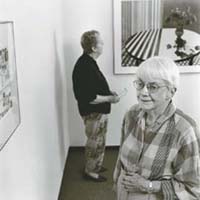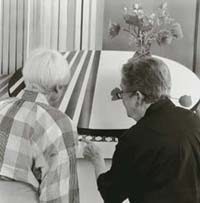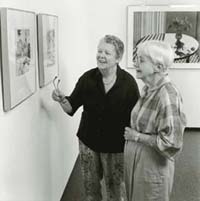 |
 |
| current issue |  |
past issues |  |
send a letter/news |  |
address update |  |
advertise |  |
about us |  |
alumni home |
Features
GiftedPage 2 of 2

|

|

|
-Mary-Leigh Smart
Artist Beverly Hallam (in black shirt) was on sabbatical in France, living across the valley from Picasso, when she bought one of his famous painted vases. Years later, that same vase found its way into one of Hallam's paintings. Famous in her own right for pioneering the use of acrylic, Hallam's work appears in many private and public collections. When her good friend, Mary-Leigh Smart, former president of the UNHArt Gallery's board of advisors, purchased Hallam's "Poppies in Picasso Vase" for the university, Smart's gift became one of the gallery's best teaching tools: an example of an artist in transition. "Poppies" represents the start of Hallam's shift from monoprinting (the textured background) to air brushing (the vivid foreground). The two smaller sketches on the right, donated by Hallam herself, demonstrate another treatment of the same still life. "That's one of the things I love about Beverly's work," says Smart. "She's always changing and developing."

-John Bryer '71 |
One of the great photographers of the 20th century, German-born Lotte Jacobi is best known for her portraits of artists and celebrities. She also experimented with photogenics, or "light drawings," produced in a darkroom using a penlight. The image John Bryer '71 bought from Jacobi on one of his visits to her New Hampshire farm is ephemeral and totally abstract. "But it's technically extremely difficult," says Bryer. "The image doesn't exist in a form you can see until you're done. She was a master." For Bryer, who was introduced to Jacobi by former UNH art professor Jim Fasenelli, the one-of-a-kind photogenic came into his life—and then left again—when he donated it to the UNH Art Gallery in 1991. "For some people, collecting is a series of conquests," says Bryer. "For me it's a dynamic process. I learn from what I collect. It teaches me about myself, and then I pass it on to someone else after it's done its work."
 "I bought these engravings with UNH in mind. My walls were already full and I thought these would be perfect for the Art Gallery."
-Edmund G. "Ted"a��Miller
"I bought these engravings with UNH in mind. My walls were already full and I thought these would be perfect for the Art Gallery."
-Edmund G. "Ted"a��Miller
|
Ted Miller understands the power of a good story. For nearly four decades, he taught English at UNH, specializing in 19th-century British literature. His gift to the Art Gallery, a series of eight engravings by William Hogarth called "The Rake's Progress," tells one of the oldest stories known to man-the tale of a life wasted by "riotous living."
"It has a very literary quality," notes Miller, "capturing the wit and satire characteristic of the period." Early in the 18th-century series (top print above), the young man is surrounded by the Martha Stewarts of the day—the dance master, the tailor and others, instructing him in the ways of fashionable society. He lives a privileged life, but alas, his good fortune leads him far astray, until, in the final engraving, he winds up in the midst of hell. (So much for "progress.") Thanks to Miller, future generations of art students, and would-be rakes, can study and learn from Hogarth's graphic tale. The power of a good story continues.
Page: < Prev 1 2Easy to print version
blog comments powered by Disqus

